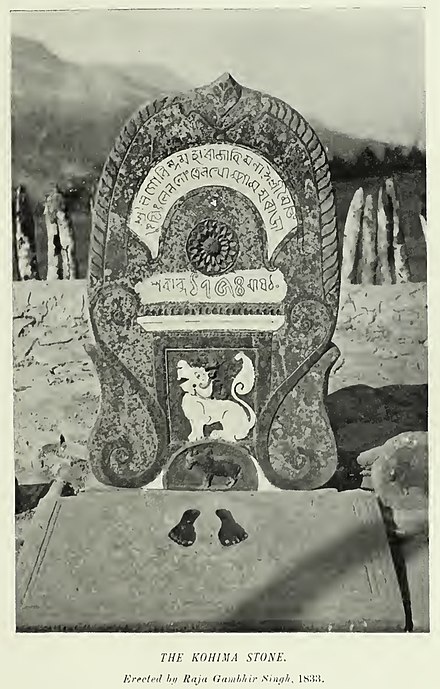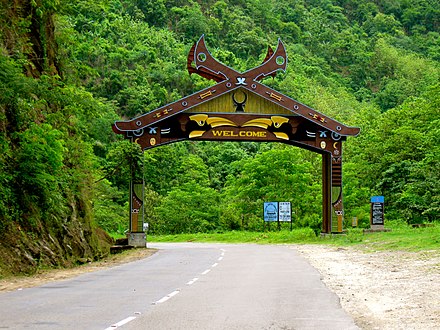Nagaland is one of the northeastern states of India. Sandwiched between Assam, Arunachal Pradesh, Manipur, and Myanmar, it is one of the smallest and least populated states in India, and one of the small handful of Christian-majority states in India.
Cities
-
Viswema — a Naga village
Other destinations
- Ntangki National Park 📍 (Ntangki National Park) — a wildlife park located in the Peren District. Home to several endangered species as well as other mammals and birds. Among them are the golden langur, white-breasted kingfisher, python and sloth bear
Understand
Very little is known about the origins of the Nagas. The Nagas had no writing systems and thus, no written records until the British era. Some scholars believe that the Nagas have their roots in either China or Mongolia and that they migrated to South Asia sometime between 1000 and 901 BC.

Among the very few records, one of the most important is the Kohima Stone Inscription, also known as the Gambhir Singh's Stone, that was erected by King Raja Gambhir Singh (alias Chinglen Nongdrenkhomba) of Manipur kingdom, in Kohima (Meitei: Thibommei), the capital of Nagaland in 1833 AD. The inscription mark the Meitei conquest and supremacy over the Naga Hills in 1832 AD. Manipuri King Raja Gambhir Singh conquered the whole Naga Hills with his military power of the Manipur Levy.
Nagaland is one of the few states in India where Christianity is the dominant religion. Missionaries and ministers came to India in the 19th century, found their way into Nagaland, and converted almost all Nagas to Christianity. Baptism is the predominant denomination, and the state is known as the only predominantly Baptist state in the world. Other major religions include Hinduism and Islam.
Nagaland has faced a violent, often brutal insurgency movement, and this has severely limited the state's economic development. Of all the insurgent movements in the North East, the Naga insurgency is perhaps the most complex of them all. Naga insurgents not only demand complete independence from India, but they also aim to incorporate all Naga-inhabited areas into one state. Given the state's proximity to Southeast Asia, the conflict often spills into neighbouring Myanmar.
Although the worst of the violence has gone away, some rebel groups continue to employ violent, brutal tactics to further their goals. The Indian government continues to negotiate with the rebels, and it is believed that the conflict will end soon.
Get in
Fly into Dimapur (IATA: DMU) or take the fast train from Guwahati which leaves daily at 6:30AM; connect to a share taxi in front of the Dimapur railway station (₹200) and reach Kohima by lunchtime. Direct buses also run daily between Guwahati and Kohima.
The back door into the state is from Sonali in Assam to Mon in the far north east in Nagaland. The advantage here is that Sonali is connected by rail and can be reached overnight and those going far north avoid backtracking, the bus to Mon leaves at midnight from Sonali.
Entry formalities
Foreign nationals no longer need a Restricted Area Permit. If flying in, you should register with police at the airport, but even this is not strictly required.
In remote areas registering with police (or even phoning and letting them know you've arrived) is advisable.
Get around

There are no rail connections in Nagaland so bus/jeep travel is generally your only option unless you are flying.
Road conditions can be terrible in some parts of the state and landslides are relatively common; enquire locally about the current conditions of specific routes.
Talk
The official language of the state is English.
Nagamese, a creole language based on Assamese, is understood and spoken by most of the locals.
As Nagaland is a tribal nation, some of the most commonly spoken tribal languages in the state are Konyak, Ao, Lotha, and Angami. You're not expected to know a word of any of these languages, but learning a few words will most certainly endear you to the locals.
As is the case with most states in North-East India, Hindi is not universally understood and very few people speak the language proficiently.
See
- Kohima, the state capital, houses the largest crucifix in Asia.

Do
Eat
A typical Naga table consists of a meat dish, a boiled vegetable dish or two, rice and a chutney (tathu). Nagas tend to prefer boiled edible organic leaves. Some common dishes are:
- "fermented bamboo shoot" (made from the tender shoot of the bamboo tree) with fish and pork.
- axone (soya bean boiled, fermented and either smoked or sun dried) with smoked pork and beef. Smoked meat is produced by keeping the meat above the fire or hanging on the wall of the kitchen for 2 weeks or longer; it can last for a year.
- Anishiis fermented yam leaves made into patties and smoked over the fire or sun dried.
Naga food tends to be spicy (chillies). There are different varieties of chillies in Nagaland, the strongest being bhut jolokia, thought to be the world's hottest chilli until 2011. The ginger used in the Naga cuisine is spicy, aromatic and is different from the common ginger. The garlic and ginger leaves are also used in cooking with meat.
Another popular dish is a soupy dish which is had with cold rice, made mostly when one feels under the weather or has a migraine, called by different names by the different Naga tribes.
Drink
Consumption of alcohol is prohibited in the state.
Stay safe
Opium abuse is still an issue in some remote villages near the Myanmar border and can result in unprovoked violence against tourists. Seek local advice and a local guide, and don't visit remote villages alone.
Respect
The various respect tips in the Northeast India article apply here. As in any other place, if you're not sure about something, just ask.
Do not divulge strong, negative opinions on the Church, tribal councils, and village elders. They are influential and venerated, and passing strong statements on them them will seriously offend the Nagas. Remember that you're in a predominantly tribal state - What may be considered acceptable in other parts of India won't be considered acceptable here. Behave accordingly.
Given the ongoing insurgency, some Nagas may be offended if you state that the National Socialist Council of Nagaland (the main insurgent group in the state) is a terrorist organisation. As a general rule, avoid having a discussion on local, tribal politics - Nagaland is a politically troubled state.